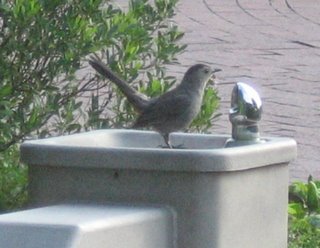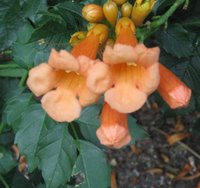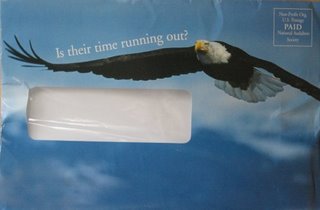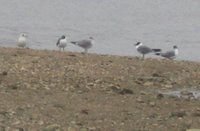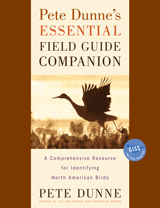 The growth of birding in the United States has opened a market for books that supplement traditional field guides. One expanding genre has specialized in a family or habitat group. There are plenty of fine books in that genre, with more published every year. A second type has covered the natural history of some or all North American bird species. The door was open for a field guide supplement devoted to identification, and that gap has now been filled with Pete Dunne's Essential Field Guide Companion.
The growth of birding in the United States has opened a market for books that supplement traditional field guides. One expanding genre has specialized in a family or habitat group. There are plenty of fine books in that genre, with more published every year. A second type has covered the natural history of some or all North American bird species. The door was open for a field guide supplement devoted to identification, and that gap has now been filled with Pete Dunne's Essential Field Guide Companion.
The present book grew out of Dunne's work revising the most recent edition of the Peterson Guide. Species descriptions in a field guide must be short to make the book portable and easy to use, and Dunne found that he wanted to write much more about how to identify birds. So he embarked on a four-year project to study every bird species regularly found in North America and to write his impressions into a guide to identification. The result is over 700 pages of fresh advice from Pete Dunne.
Instead of finer plumage and structural details, Pete Dunne's Essential Field Guide Companion is based on GISS, or "General Impression of Size and Shape." This method of bird identification had its start with Roger Tory Peterson but was developed into an art form by birders who worked in and around Cape May, NJ, in the late twentieth century. GISS emphasizes size, shape, and behavior as the easiest route to field identification. The language of GISS is inherently subjective, and thus difficult to render in field guide form. "Robust" to one birder might be "chunky" to another, and a tern or swallow species that one birder finds more graceful than the rest may not appear so to another birder. At the same time, the differences are real, and through careful study a birder can learn to separate many species on the basis of these impressions without ticking off every field mark.
Individual species accounts, which comprise the bulk of the Field Guide Companion, are structured to guide readers through not just the information, but the process of identification. Thus one starts by narrowing down the list of possibilities by range, time of year, and habitat, and then one moves on to specific field marks and vocalizations. In the field, it does not work quite so neatly; sights and sounds are sometimes so fleeting that one does not have time to work through a list of considerations. But the process is still the same: narrow down to a handful of likely suspects, then look for specific details that clinch the identification.
All species accounts are divided into a standard set of sections, making them easy to compare with each other. The first part of each entry covers factors important for the process of elimination: status, distribution, habitat, cohabitants, and movement.
- Status refers to how common a species is.
- Distribution gives a list of places where a species is found, and could have been much more easily handled with range maps, which are now standard in most field guides.
- Habitat is useful for ruling out species that are specialists in a different habitat type. Dunne notes when a species is found in different habitats in winter and summer.
- Cohabitants could be more useful if it were more consistent. In some cases it seems to mean species found in the same environment and in others it seems to mean species that flock together.
- Movement/Migration includes both migration routes and whether a bird tends to wander far from its normal range.
The second part of each species account provides the details needed for species identification. These include a physical description, behavioral notes, flight, vocalizations, and "pertinent particulars."
- Description covers the basic points of identification. While these are more easy to comprehend from drawings or photographs than words, Dunne adds to the understanding of the images by pointing out key subjective impressions, like blue grosbeak being "burly" while indigo bunting is "less angular" and "more finely proportioned."
- Behavior is very helpful with certain groups of birds like the Calidris sandpipers. As Dunne points out, these species will frequently be found on different parts of the mudflats; sanderlings chasing the receding waves is only one example of this tendency.
- Flight focuses on wing shape and wingbeat pattern. Identifying birds on the wing is a difficult skill that takes much practice to master since the traditional field marks can be hard to spot.
- Vocalizations include songs, contact calls, and flight calls. Recordings are a better way of learning avian voices, but Dunne's descriptions are still helpful. At the very least, he provides alternate mnemonics and comments of the quality of songs and calls.
- Pertinent Particulars deals with distinguishing similar species from each other or with points not addressed in the categories above. This last category is not given for all species.
The species accounts provide the reader with a wealth of information, too much to absorb in one sitting. This book is not meant to be carried in the field. Aside from not being pocket-sized, it is too heavy for convenient backpacking. Rather, this book is for home reference. It may be best used to read up on bird families one expects to see ahead of a field trip. Alternately, one can consult on the nuances of a tricky identification after being out birding. Either way, the book is a valuable resource to have when the field guide illustrations do not give quite enough information. As with all of Dunne's works, this book is written with a sense of humor and includes a few jokes in the text.
This book is probably best suited for beginning and intermediate birders, who have the most to gain from Dunne's GISS descriptions. Beginning birders in particular would do well to learn the GISS methods, even if the species accounts are a little overwhelming at first. Starting from structure and habits can save many misidentifications. More advanced birders will have their own subjective ways to tell birds apart, but may still benefit from Dunne's commentary. Since
Pete Dunne's Essential Field Guide Companion has no illustrations at all, someone using this book will need to have a standard field guide like the excellent
Sibley Guide to Birds or other more portable guides for use in the field.
Full citation:
Pete Dunne,
Pete Dunne's Essential Field Guide Companion: A Comprehensive Resource for Identifying North American Birds. New York: Houghton Mifflin, 2006. Pp. xiv, 710; index. $29.95 cloth. ISBN: 0618236481.
To purchase:




